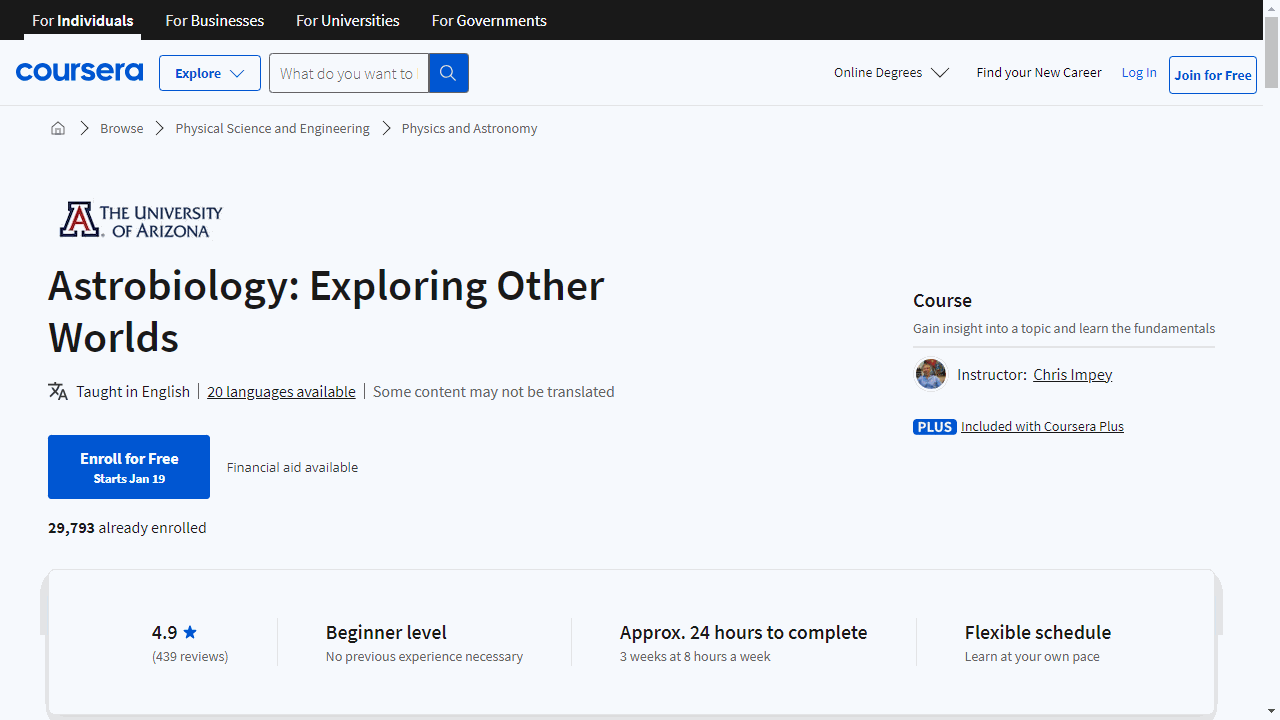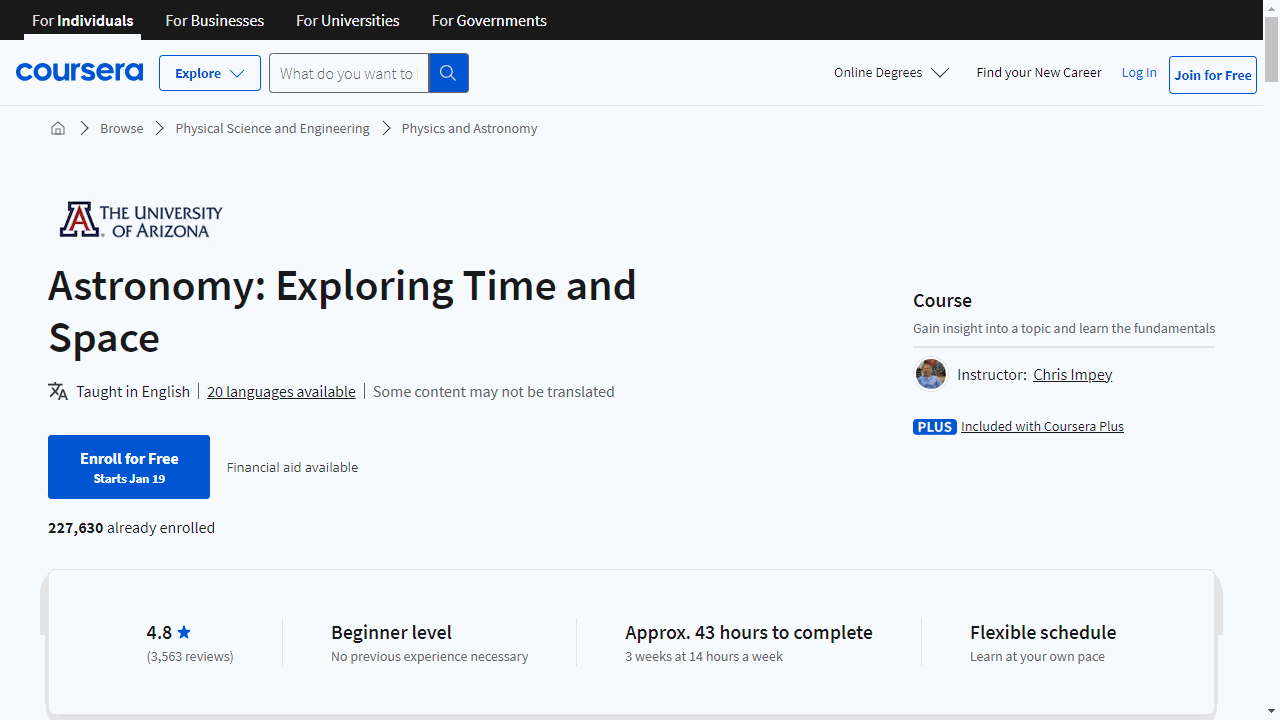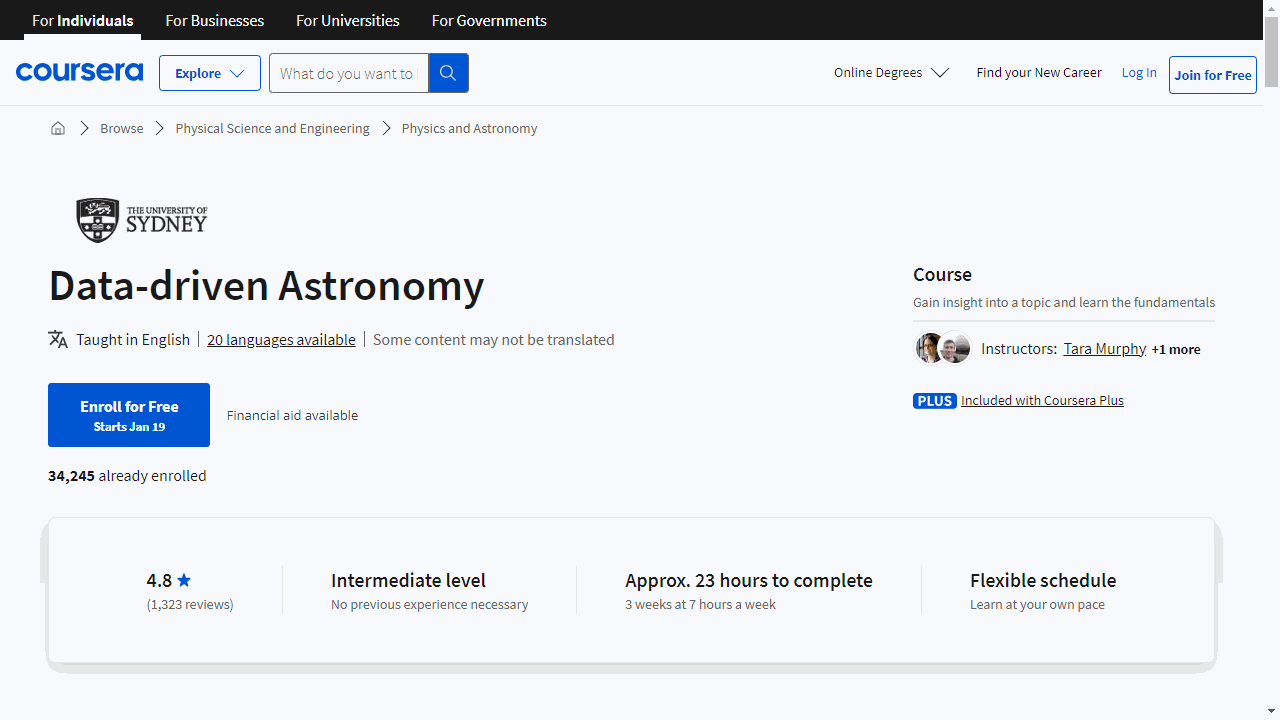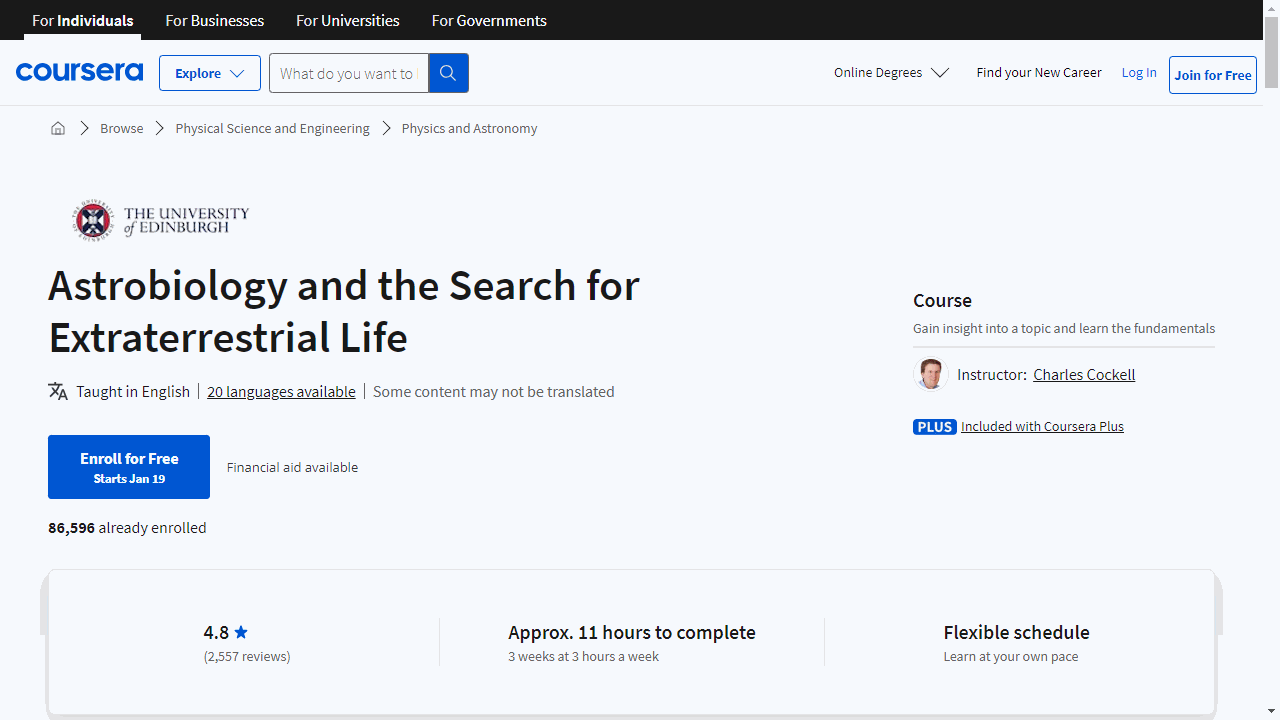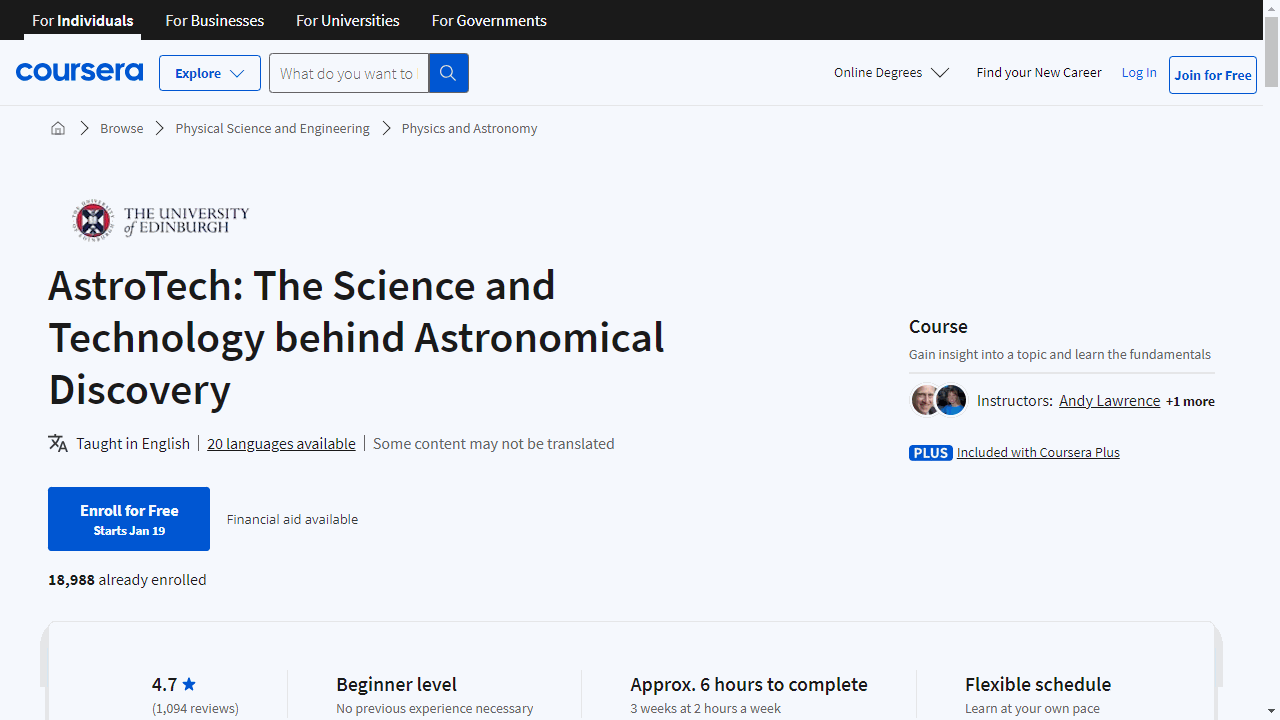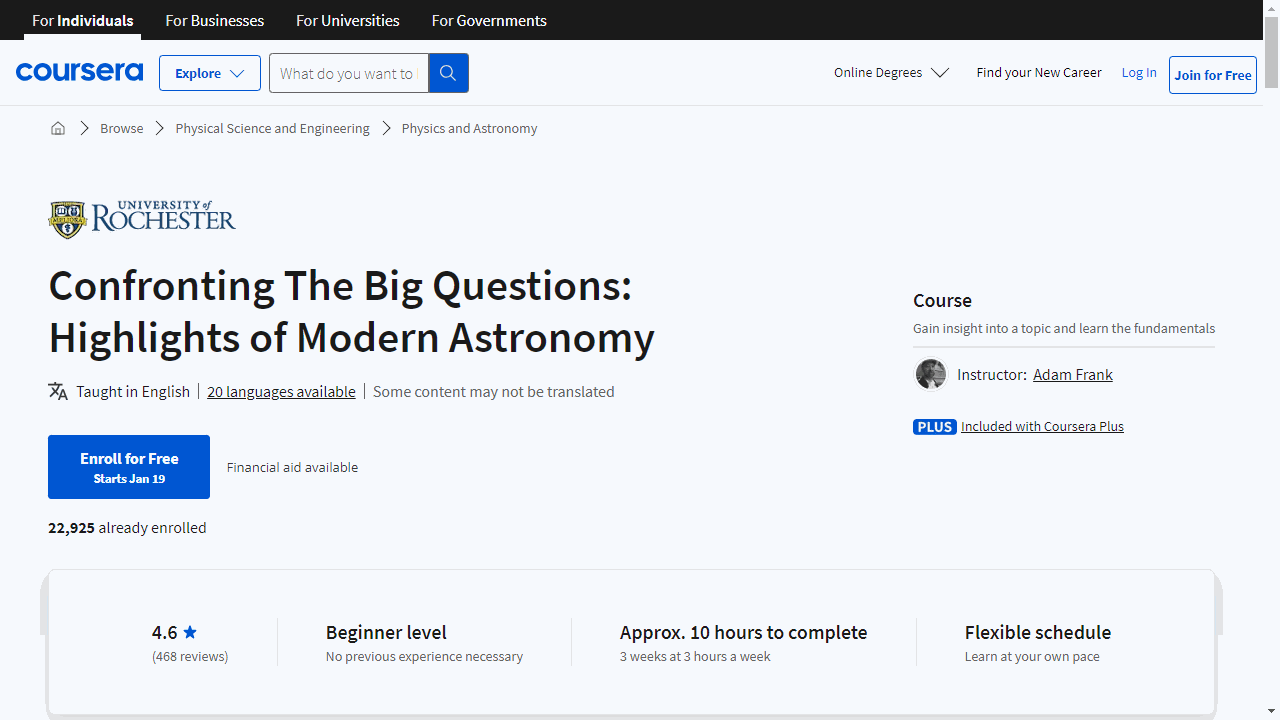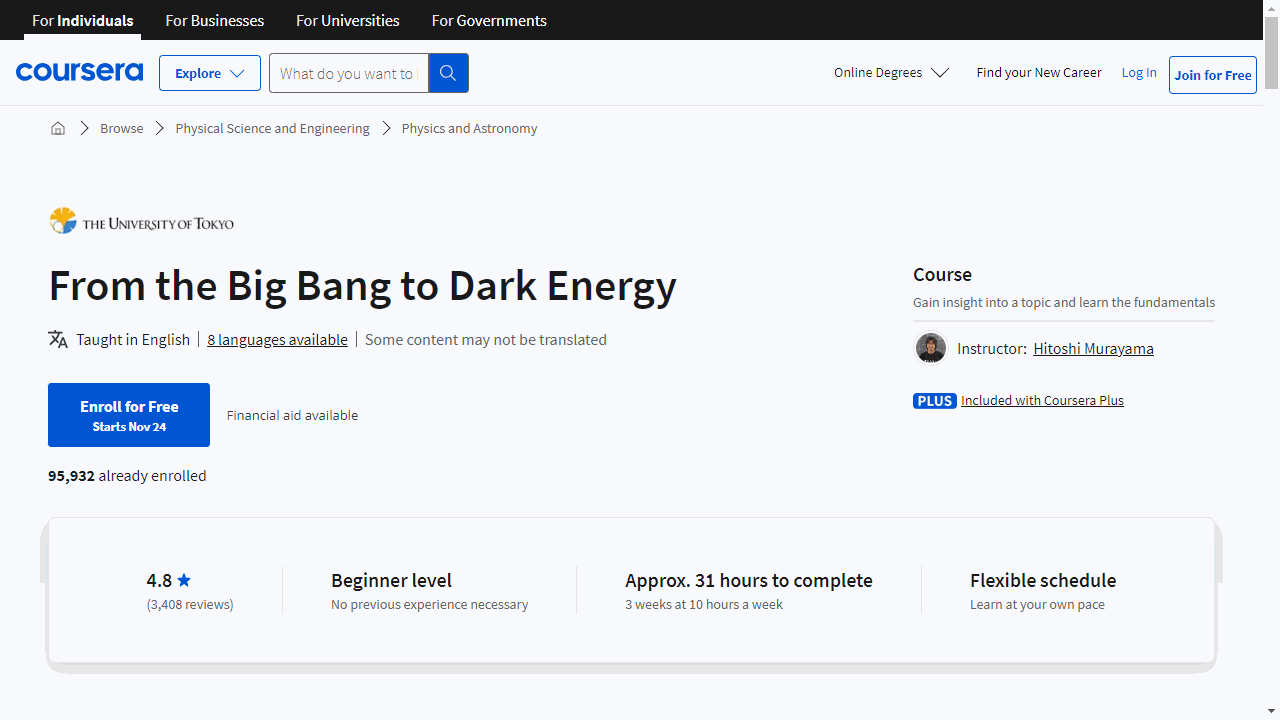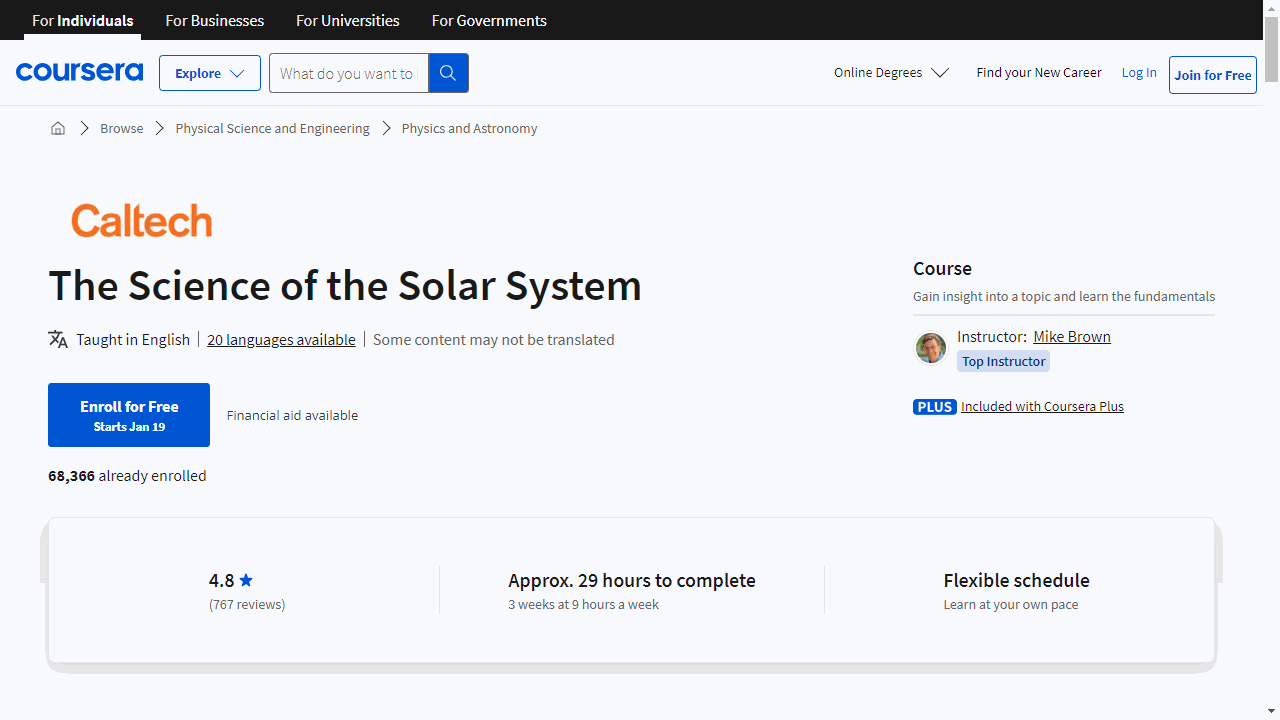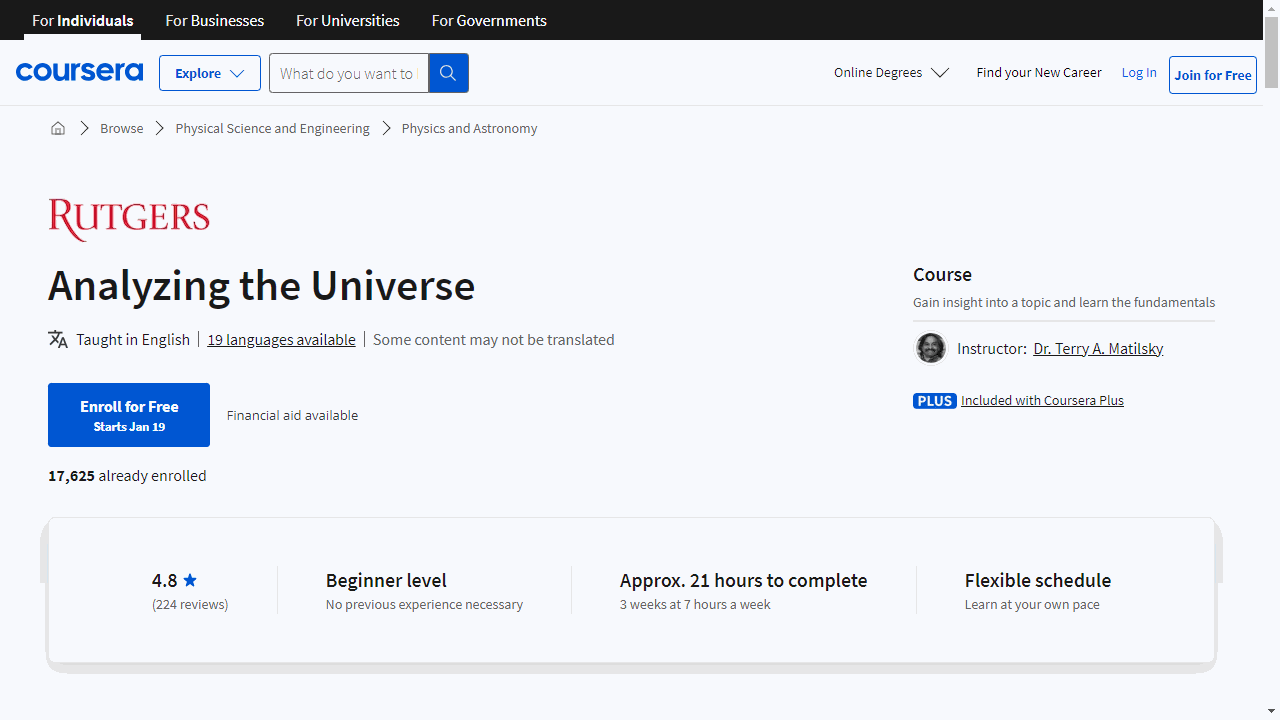Exploring the vastness of space and the potential for life beyond Earth is a captivating pursuit.
So many questions remain unanswered, from the origins of the universe to the possibility of extraterrestrial intelligence.
Finding a high-quality astronomy course can be a challenge, especially with so many options available on Coursera.
You want a course that will deepen your understanding of celestial phenomena, inspire your curiosity, and equip you with the knowledge to explore the wonders of the universe.
For the best astronomy course overall on Coursera, we highly recommend Astrobiology: Exploring Other Worlds by the University of Arizona.
It takes you from the basics of planet formation to the search for extraterrestrial intelligence, offering a comprehensive guide to the potential for life in the universe.
This isn’t the only stellar (pun intended) option, though.
Keep reading for other recommendations for beginners, intermediate learners, and experts, as well as courses focusing on specific areas like black holes and space exploration.
Astrobiology: Exploring Other Worlds
Provider: University of Arizona
This course is a comprehensive guide for you to understand the potential for life in the universe and the scientific efforts to discover it.
It takes you on a journey from the familiar planets in our Solar System to the mysterious exoplanets orbiting distant stars.
Starting with the basics, you’ll learn about planet formation and the surprising diversity of worlds out there, including the intriguing Hot Jupiters.
You’ll also explore the concept of water worlds and get a sense of the vast array of planets in the Milky Way.
As you progress, you’ll delve into the methods astronomers use to discover new planets.
You’ll understand the role of gravity and the Doppler shift in the Radial Velocity and Transit methods.
These techniques are crucial for detecting exoplanets and determining their composition.
In the third week, the course shifts focus to the conditions necessary for life.
You’ll examine the chemical building blocks of life and the concept of the habitable zone.
This knowledge helps in identifying which exoplanets might support life.
The following week, you’ll investigate the origins of life on Earth, the development of our atmosphere and oceans, and the characteristics that define life.
You’ll also consider the potential for life in extreme environments, on Mars, and on other moons.
The course then takes a deeper dive into the evolution of complex life and intelligence.
You’ll study DNA, genetics, and the history of life on Earth, including the evolution of humans.
In the final module, you’ll engage with the search for extraterrestrial intelligence (SETI).
You’ll discuss the Drake Equation, which estimates the number of advanced civilizations, and the possibilities of interstellar communication and travel.
Throughout the course, interactive writing assignments and a final project where you design an exoplanet mission proposal keep you engaged and apply what you’ve learned.
Astro 101: Black Holes
Provider: University of Alberta
This course takes you on an in-depth exploration of black holes, from their pop culture depictions to the hardcore science that defines them.
You’ll start with the basics, understanding the relationship between gravity and light, and how these fundamental forces lead to the formation of black holes.
The course simplifies complex concepts like Doppler Shift and Newtonian Gravity, making them accessible and engaging.
As you progress, you’ll examine the life cycles of stars, crucial for grasping how black holes come into being.
You’ll hear from experts like Dr. Erik Rosolowsky on the Sun’s family tree and Dr. Kelsey Hoffman on the intriguing concept of super-Earths.
The course also demystifies spacetime and Einstein’s theory of relativity, with interactive elements that make learning about these abstract concepts fun.
Interviews with renowned scientists, including Dr. Douglas Gingrich and Dr. Jeremy Heyl, offer you a window into the latest research and theories.
When it comes to black holes themselves, you’ll delve into the various types, from stellar mass to supermassive, and discuss their formation, behavior, and impact on the surrounding universe.
Experts like Dr. Gregory Sivakoff and Dr. Daryl Haggard provide insights into the ongoing research and discoveries in the field.
You’ll also tackle the stranger aspects of black holes, such as the event horizon and singularity, and even the theoretical concept of wormholes.
The course brings in quantum mechanics and Hawking Radiation, explained in a way that’s understandable, with help from authorities like Dr. Don Page.
Observation techniques are a key part of the course, where you’ll learn how astronomers detect and study black holes using various methods, including X-ray telescopes.
Dr. Fiona Harrison shares why Sagittarius A* is a significant focus of study, enhancing your knowledge of observational astronomy.
The course culminates with the exciting topic of gravitational waves, a revolutionary way to observe the cosmos.
You’ll learn about their detection and what they reveal about the universe’s most violent events, like black hole and neutron star collisions.
Interactive learning tools, expert interviews, and real-world applications make “Astro 101: Black Holes” not just educational but truly engaging.
Astronomy: Exploring Time and Space
Provider: University of Arizona
This comprehensive program guides you through the evolution of astronomy, from ancient times to cutting-edge discoveries.
You’ll begin by understanding how early civilizations interpreted the sky and how pivotal figures like Copernicus and Galileo set the stage for modern astronomy.
Your journey starts with a writing assignment that connects historical insights to contemporary science.
As you progress, you’ll gain practical knowledge about the night sky.
Learn to track stars, understand the Moon’s phases, and identify planets with ease.
This section equips you with the skills to appreciate the celestial dance overhead.
The course then equips you with the tools of the trade.
Discover how telescopes and technologies like adaptive optics extend our gaze beyond the visible spectrum.
You’ll explore the Hubble Space Telescope’s contributions and the latest in gravitational wave research.
A focused writing assignment on telescopes will test your newfound expertise.
Delving into the microcosm, you’ll explore atoms, energy, and the forces shaping the universe.
This foundational knowledge is crucial for grasping larger cosmic phenomena.
Your exploration of the solar system will reveal the unique characteristics of planets and moons, the intrigue of Mars, and the potential for future exploration.
This module highlights the dynamic nature of our cosmic neighborhood.
Space exploration takes center stage as you examine NASA’s role, the burgeoning commercial space sector, and the technologies that may one day propel us to other worlds.
The search for exoplanets will captivate you as you learn about methods for detecting these distant worlds and the quest for Earth-like conditions.
Your writing assignment on exoplanets will allow you to synthesize this knowledge creatively.
Understanding the life cycle of stars, from birth to their explosive ends, reveals the universe’s dynamic nature.
You’ll study the Sun, stellar evolution, and the enigmatic phenomena of black holes and supernovae.
In the galaxies module, you’ll traverse the Milky Way, uncover the mystery of dark matter, and witness the cosmic ballet of colliding galaxies.
This segment expands your perspective to the grand scale of the universe.
Cosmology invites you to ponder the Big Bang, the nature of dark energy, and the concept of the multiverse.
Your final writing assignment will challenge you to explore these profound topics.
The course concludes with astrobiology, where you’ll speculate on life’s origins, the potential for extraterrestrial intelligence, and the fascinating Drake Equation.
Data-driven Astronomy
Provider: The University of Sydney
This course is a unique blend of astronomy and data science, designed to give you practical skills in analyzing the vast amounts of data generated by astronomical research.
You’ll start by exploring pulsars, learning to stack images for better analysis.
The course quickly moves beyond basic techniques, teaching you how to handle large datasets efficiently.
You’ll discover improved methods to calculate stacks, bypassing the slow median approach.
The journey continues with big data challenges, such as understanding supermassive black holes.
You’ll master cross-matching, a crucial technique for identifying celestial objects across different datasets.
The course introduces you to k-d trees, an advanced algorithm that drastically speeds up this process.
SQL, a powerful database management language, will become a tool in your arsenal as you learn to query databases, join tables, and write sophisticated queries.
These skills are essential for investigating exoplanets and delving into the lifecycle of stars.
Machine learning is another highlight of the course.
You’ll build decision tree classifiers and regression models to estimate cosmic distances and classify galaxies.
This hands-on experience with machine learning prepares you to tackle real-world astronomical problems.
Interviews with experts like Karen Masters and Jon Jenkins bring the material to life, offering you insights from leading astronomers.
By the end of the course, you’ll be equipped to manage big datasets, understand complex algorithms, and apply machine learning to unravel the mysteries of the universe.
If you’re eager to combine your passion for astronomy with data science, this course will empower you with the skills to make significant contributions to the field.
Get ready to classify galaxies, predict cosmic events, and maybe even make a discovery of your own.
Astrobiology and the Search for Extraterrestrial Life
Provider: The University of Edinburgh
This course goes beyond traditional astronomy to explore the origins and nature of life in the universe.
You’ll begin by defining life, examining its building blocks, and understanding the complex web of organisms that make up the tree of life.
The course then takes you back in time to investigate how life might have started on Earth, considering various locations and alternative chemistries.
The journey continues as you explore the solar system’s formation and what makes planets like Earth hospitable for life.
Mars is a key focus, where you’ll delve into its potential as a past or present abode for life and the scientific missions that are revealing its secrets.
Beyond Mars, you’ll discover why icy moons such as Europa and Enceladus are exciting candidates in the search for alien life.
The course equips you with knowledge about biosignatures, the vital clues that could indicate life on other planets, and teaches you how these signs are detected.
The quest for extraterrestrial life also addresses the possibility of intelligent civilizations beyond Earth.
You’ll consider how we might communicate with them and the profound implications such contact would have on society.
With guidance from experts at the University of Edinburgh, you’ll be immersed in the latest astrobiology research and methodologies.
This course is designed to satisfy your curiosity about life in the cosmos and to provide a comprehensive understanding of where we might find it.
AstroTech: The Science and Technology behind Astronomical Discovery
Provider: The University of Edinburgh
Over six weeks, this course unpacks the complexities and wonders of the cosmos, along with the cutting-edge tech that unveils its secrets.
Starting off, you’ll explore how we’ve come to understand the universe, the pivotal moments in astronomy, and the challenges of studying space.
You’ll see how science and technology, like a horse and cart, work hand in hand to advance our knowledge.
In the second week, you’ll focus on visualizing the universe, examining if other stars are similar to our Sun, and understanding the mechanics of telescopes.
You’ll also discover the cosmic connection we share with the stars – we’re all made from stardust.
Week three introduces you to the atmosphere’s impact on astronomy and the quest to find black holes.
You’ll delve into the mechanics of rockets and spacecraft, and consider the economics of space exploration, all while gaining a new perspective on the scale of the universe.
The fourth week is about capturing starlight and the history of galaxies.
You’ll learn about light detection technologies, such as CCDs and infrared detectors, and speculate on future advancements in this field.
Computers and their role in astronomy take the spotlight in week five.
You’ll see how they’re essential in monitoring asteroids, managing vast data, and leveraging the internet.
You’ll also confront the limits of current tech and learn about the significance of megaparsecs and petabytes.
Finally, week six delves into the relationship between light, atoms, and motion.
You’ll investigate the accelerating universe, dark energy, and the function of spectrographs, imagining what an ideal spectrograph could achieve.
Each week is supplemented with additional information to enrich your learning experience.
Knowing the Universe: History and Philosophy of Astronomy
Provider: University of Arizona
This course takes you on an educational adventure from the earliest stargazers to the cutting-edge of cosmic discovery.
You’ll begin with Ancient Astronomy, exploring how the Greeks, Chinese, and Mayans used the stars to create calendars and predict eclipses.
Then, you’ll witness the Birth of Science, rubbing shoulders with the likes of Copernicus, Galileo, and Newton, whose groundbreaking work laid the foundations for modern astronomy.
As you delve into the science of telescopes, you’ll gain practical insights into how these instruments have revolutionized our view of the universe.
You’ll learn about the Copernican Model, the laws of gravity, and how they’ve contributed to major scientific advancements.
The course doesn’t shy away from the complexities of Quantum Mechanics and General Relativity, breaking them down so you can grasp how they explain the behavior of the Sun, galaxies, and even black holes.
You’ll also explore the Big Bang theory, the concept of the multiverse, and the search for life beyond Earth through astrobiology.
Interactive quizzes, writing assignments, and reflective activities ensure that you’re not just passively learning; you’re engaging with the material to truly understand the wonders of the universe.
Confronting The Big Questions: Highlights of Modern Astronomy
Provider: University of Rochester
This course offers a comprehensive journey through the universe, starting with the essentials of scientific notation and our solar system’s structure.
You’ll compare the rocky landscapes of terrestrial planets to the swirling atmospheres of gas and ice giants, and even examine the cosmic leftovers known as construction debris.
The search for exoplanets is a thrilling part of the curriculum, where you’ll learn about the methods astronomers use, such as observing transits and applying the Doppler Shift, to discover new worlds.
The course doesn’t shy away from the big question: Are we alone?
You’ll delve into the chemistry of life, understanding DNA and RNA, and consider the conditions necessary for life to emerge elsewhere in the universe.
Stars are the next focus, with lessons on nuclear fusion and the life cycles of stars, from protostars to the enigmatic end stages like white dwarfs and supernovas.
You’ll also navigate through the complexities of black holes and the fabric of spacetime, gaining insights into special and general relativity.
Galactic exploration is a key component, where you’ll study the Milky Way, learn about the interstellar medium, and unravel the role of metallicity in star formation.
The course also demystifies dark matter and introduces you to the diverse types of galaxies and the cosmic web that connects them.
As you reach the grand finale, the course addresses the origins of the universe with discussions on the Big Bang, the early universe’s phase transitions, and the cosmic microwave background.
You’ll even contemplate the concept of dark energy and the fate of the universe, including the intriguing idea of a multiverse.
From the Big Bang to Dark Energy
If you’re eager to unravel the mysteries of the cosmos, this course is a must.
It’s a comprehensive journey through the fundamental concepts of physics, tailored to ignite your curiosity and deepen your understanding of the universe.
The course kicks off with the essentials, explaining the mechanics behind night and day, the seasons, and the elliptical orbit of Earth.
It’s a practical start, grounding you in the phenomena you experience daily.
As you progress, the course delves into the origins of the universe with a series of lessons on cosmic expansion.
You’ll learn how observing distant galaxies allows us to peer back in time, providing clues to the universe’s infancy.
The narrative then shifts to the birth of elements, tracing the origins of matter from the simplest atoms to the building blocks of life.
The course also demystifies the Higgs Boson, shedding light on its crucial role in the fabric of space and time.
Dark matter and dark energy are next on the agenda, enigmatic components of the universe that dictate the structure of galaxies and the rate of cosmic expansion.
These lessons offer a window into the cutting-edge research that’s reshaping our understanding of the cosmos.
If you enjoy a good challenge, optional problems are available to test your knowledge and apply the concepts learned.
In the latter part of the course, you’ll explore the fate of the universe, including theories like the Big Rip and the role of dark energy in cosmic destiny.
It’s a thought-provoking segment that encourages you to ponder the ultimate questions of existence.
The course is rounded out with extra lectures on groundbreaking discoveries like gravitational waves and black holes, providing a comprehensive view of modern physics.
“From the Big Bang to Dark Energy” is more than just a physics course; it’s an intellectual adventure that equips you with a deeper appreciation for the universe’s wonders.
The Science of the Solar System
Provider: Caltech
This course is a comprehensive journey through our solar system, offering a deep dive into the planets, moons, and beyond.
You’ll start with Mars, uncovering its climate and geological history.
You’ll examine evidence of water, analyze Martian topography, and review the groundbreaking discoveries from missions like Mariner 9 and the Curiosity Rover.
Discussions on Martian craters, valley networks, and atmospheric escape will give you a solid understanding of the Red Planet.
Next, you’ll set your sights on Jupiter, delving into its internal structure and magnetic fields.
You’ll learn how scientists measure planetary densities and what these figures reveal about celestial bodies.
The course also covers the intriguing phenomena of hot Jupiters and the mysteries of Saturn and the ice giants.
The small bodies of the solar system, such as comets and asteroids, are also on the agenda.
You’ll explore their origins, compositions, and the role they play in our cosmic neighborhood.
The course touches on the Oort cloud, the Kuiper belt, and even the debate surrounding the hypothetical Planet Nine.
But it’s not just about rocks and gas giants; the course also probes the potential for life elsewhere.
You’ll investigate the conditions on Europa and Enceladus, consider the unique environment of Titan, and discuss the habitable zones that might harbor extraterrestrial life.
Throughout the course, you’ll be introduced to scientific tools and methods, including gamma-ray spectroscopy, thermal spectroscopy, and the use of telescopes like Subaru.
You’ll gain insights from the Opportunity and Curiosity rovers’ geochemical analyses and learn about upcoming missions like the Europa Clipper.
Bonus lectures add even more value, offering perspectives on the moon’s formation, the reclassification of Pluto, and the seasonal changes on Titan.
Analyzing the Universe
Provider: Rutgers the State University of New Jersey
This course transforms the way you see and understand the cosmos.
You’ll begin by exploring the essence of images – how we capture and interpret light from the stars.
The first lectures lay the groundwork, teaching you about image formation and the intriguing process of how X-rays provide a unique view of the universe.
As you progress, you’ll get hands-on with DS9, an advanced software tool used by astronomers to analyze real celestial data.
This isn’t just theoretical; you’re working with the same tools the pros use.
The course then takes you through the statistical methods behind astronomical discoveries and introduces you to atomic spectra – the starlight signatures that reveal a star’s composition.
You’ll also tackle the cosmic distance scale, learning to measure the vast distances in space.
In the following weeks, you’ll master the HR Diagram, a critical tool for classifying stars, and delve into the lifecycle of stars, focusing on the intriguing white dwarf stage through a case study of GK-Per.
Orbits and gravity take center stage in Week 4, where you’ll understand the forces shaping the movement of celestial bodies.
The Doppler Shift and its effects on light will be demystified, and you’ll study pulsars like Cen X-3, the universe’s precise clocks.
Week 5 reveals the universe’s ability to recycle itself, with a focus on supernova remnants like Cas-A.
You’ll learn how these cosmic events contribute to the cycle of stellar evolution.
The course culminates with a journey through time, examining the past and future of the universe.
You’ll expand your understanding of the cosmic distance scale and grasp the full scale of space.
Each week is supported by a wiki, enhancing your learning experience with a rich resource of information.
By the end of “Analyzing the Universe,” you’ll not only have a comprehensive understanding of astronomy but also practical experience with the tools that unlock the secrets of the stars.
